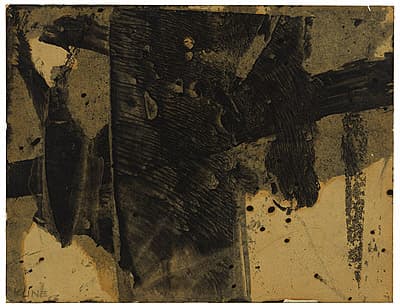
Franz
KLINE
United States of America
1910
–
1962
Oyster liver
1956
oil
on laid on paper on composition board
signed and dated l.l. in pencil "Kline 56".
sheet
21.4 (h)
x 27.8 (w)
cm
Purchased 1980
National Gallery of Australia, Canberra
NGA 1980.3409
© Franz Kline. Licensed by Viscopy
- Galerie Maeght, New York;
- from whom bought by the National Gallery of Australia, October 1980
- Dennis Hopper and the New Hollywood
- Australian Centre for the Moving Image (ACMI) 12 Nov 2009 – 25 Apr 2010
- Abstract Expressionism: the National Gallery of Australia celebrates the centenaries of Jackson Pollock and Morris Louis
- 14 Jul 2012 – 24 Feb 2013
- Matthieu Orléan (ed.), Dennis Hopper and the new Hollywood, Paris: La Cinémathèque Française 2009, illus b&w, p. 86
Untitledand Oyster liver are among a number of Kline’s preliminary sketches created during the 1950s. These painted drawings were produced in the hundreds and were kept in the artist’s studio until he selected a drawing to form the basis of one of his paintings. Despite the powerful energy of Kline’s canvases, these draft sketches reveal that the artist’s creative process was not one of spontaneous action, but rather one of careful selection and practised control. Integral to his process was the scaling-up of such drawings, using a freehand technique as well as a Bell-Opticon projector. Furthermore, Untitled is an example of Kline’s preference for working on the torn pages of telephone books: a cheap support on which he could freely and inexpensively plot his compositions.
These drawings provide bookends for Kline’s most celebrated creative period: between 1950 and 1956, during which he worked almost exclusively with a dramatic palette of only black and white. Working at night, under artificial light, this extreme colour reduction allowed him to heighten the psychological charge of his images with an emphasis on form above colour, which, once removed, could not interrupt the dynamic thrusts, angles and action of the loaded brushstroke. By 1956 Kline had begun to re-introduce colour into his compositions and Oyster liver shows this early and gradual addition of tonal variation.
In his analysis of the artist’s black-and-white paintings, David Anfam makes a strong argument that links Kline’s painterly concerns with the sensibilities of the American photographers of the New York School, particularly the work of Robert Frank.[1] Both Kline the painter and Frank the photographer observed New York City through a black-and-white veil—its industrial power and speed, as well as evoking the loneliness of its inhabitants—using severe cropping, an enlargement of detail and deliberate collapsing of spatial depth.
Jaklyn Babington
[1] David Anfam, Franz Kline: Black and white 1950–1961, Houston: The Menil Collection, 1994, pp. 20–21
The Gallery also holds Kline’s untitled illustration for Frank O'Hara’s Poem, part of a portfolio of 21 prints, published by Morris Gallery in 1960
